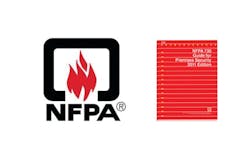NFPA creates new security controversy
Some say that the National Fire Protection Association (NFPA) has exceeded reasonable bounds by proposing that it issue the latest revision of NFPA 730: Premises Security Guide as a code rather than a standard. A code is not a law, but codes are adopted by municipalities and by that action become law.
If you were in or around security back in 2004, you may remember the controversy that erupted when the NFPA stuck its nose into the world of security by launching the development of its two security standards - NFPA 730: Premises Security Guide and NFPA 731: Standard for the Installation of Electronic Premises Security Systems.
Many in the security industry were aghast at the idea, asserting that fire and security are two different realms. On the other hand, there are many companies that sell and install both fire and security systems, and the membership of the NFPA includes many security professionals. Still, with two security industry associations—one covering the practice of security (ASIS International) and the other covering the technology of security (Security Industry Association), plus other associations (such as the International Security Management Association), why are the fire folks writing security standards?
Many security industry folks currently don’t know that in 1994 the insurance industry approached the NFPA—then nearly 100 years old in contrast to ASIS’s 40 years—to have the NFPA Standards Council take on the task of crafting security standards.
This makes sense if you consider that the insurance companies already had long experience with fire insurance and the role that fire codes play in preventing fire disasters, and thus in reducing the number and size of fire insurance claims. So with crime trends increasing over time and impacting insurance claims, it would seem to be a logical first step for the insurance industry to contact the NFPA’s Standards Council to develop security codes that would help reduce the impact of crime and cut down on crime-related insurance claims.
Many of the people and companies that design, sell, install and test fire systems also design, sell, install and test security systems. This means that at least some level of expertise in security and security systems resides within the NFPA. In fact, in the early days of electronic security systems there was one "low voltage industry" and that term encompassed burglar alarm, fire, and security systems—all three of which generate alarms signals. So from certain perspectives, the NFPA’s membership would not be total strangers to security or to initiatives that would reduce insurance claims.
The NFPA delayed their standards efforts for a few years due to strong protests from the security industry (see www.nfpa-security-codes.com/history). But when no security associations stepped up to the plate to create security standards, the insurance industry went back to the NFPA in 2004 and asked once again to have security codes developed.
The result of the standards effort—which included participation by individuals representing various security industry interests—were NFPA 730 (published in 2005) and 731 (published in 2006).
The two standards underwent revisions in 2008 and 2011 through an open process that again included individuals representing various security industry interests. As time progressed, the standards have gained more and more acceptance within the security industry.
What is all the fuss about today?
In recent years, the security industry has advanced significantly to embrace many types of threats, while the fire industry still remains focused on a single threat. The security industry could make a case that "in today’s world" you need the security folks writing the standards. In fact, in 2001, ASIS established its Commission on Guidelines and in 2008 decided that it should begin developing security standards. There has been something of a competition between ASIS and NFPA regarding standards, and both organizations developed a business continuity standard and lobbied for its’ adoption by the U.S. Department of Homeland Security (DHS).
In 2009, the DHS designated NFPA 1600: Standard on Disaster/Emergency Management and Business Continuity Programs, for adoption under its Voluntary Private Sector Preparedness Accreditation and Certification Program (PS-Prep). Then in 2010, the DHS announced the adoption of the ASIS American National Standard for Organizational Resilience for PS-Prep.
In the face of the friendly competition between the two organizations (after all, ASIS members have been part of the NFPA standards development process and vice versa), now comes a new situation that has many potentially large impacts on property owners, business owners, manufacturers and service providers: The NFPA wants to change the 730 guideline into a code.
For those municipalities who have enacted blanket adoptions of NFPA codes, the new security code would have the force of law.
However, the NFPA is an open process and is accepting comments on its proposed revisions to 730 and 731. If you want to learn more and include your voice in the decision process, download the proposed revisions and the NFPA comment form at www.nfpa-security-codes.com/download to learn about the potential impacts, both good and bad, that others have discovered and shared, and contribute your comments to the NFPA process. The deadline to submit comment is Nov. 16.
About the Author

Ray Bernard, PSP, CHS-III
Ray Bernard, PSP, CHS-III, is the principal consultant for Ray Bernard Consulting Services (RBCS), a firm that provides security consulting services for public and private facilities (www.go-rbcs.com). In 2018 IFSEC Global listed Ray as #12 in the world’s top 30 Security Thought Leaders. He is the author of the Elsevier book Security Technology Convergence Insights available on Amazon. Ray has recently released an insightful downloadable eBook titled, Future-Ready Network Design for Physical Security Systems, available in English and Spanish.
Follow him on LinkedIn: www.linkedin.com/in/raybernard.
Follow him on Twitter: @RayBernardRBCS.
